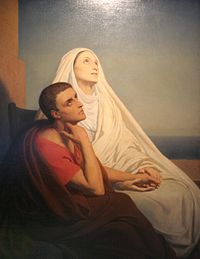Saint Monica
Saint Monica | |
|---|---|
 | |
| Widow | |
| Born | 331 Roman Africa |
| Died | 387 Ostia, outside of Rome |
| Venerated in | Roman Catholic Church, Eastern Orthodox Church, Anglicanism and the Lutheranism |
| Major shrine | Sant'Agostino, Rome |
| Feast | 27 August (Roman Catholic Church, Church of England, Lutheran Church - Missouri Synod) 4 May (pre-1969 General Roman Calendar, Eastern Orthodox Church, Evangelical Lutheran Church in America, Episcopal Church in the United States of America) |
| Attributes | depicted as a widow |
| Patronage | patience, married women, homemakers and housewives, mothers, wives, widows, alcoholics, difficult marriages, disappointing children, victims of adultery or unfaithfulness, and victims of (verbal) abuse |
Monica (or Monnica) (331[1] – 387) is a Christian saint and the mother of Augustine of Hippo, who wrote extensively of her virtues and his life with her in his Confessions.
Life
Monica was of Berber descent[2][3][4]. She was born in Roman Africa.[5] Her parents brought her up as Christian and married her to an older pagan man named Patricius, a curialis of Thagaste (located in modern-day Souk Ahras, Algeria). He was a man of kindness[6], but also a man given to violent tempers and adultery. Augustine reports that despite the prevalence of domestic violence at the time, because of her obedience to him, Monica was never beaten by Patricius. Initially, she got on poorly with her mother-in-law, but Monica won her over by her respectfulness, patience, and gentleness.[7]
Monica attended church daily and cultivated the virtue of patience. She advised other wives, who were beaten, to hold their tongues around their husbands, rather than proudly withstand them.[6] Eventually, she converted Patricius to Christianity and calmed his violent nature.
Monica bore three children, among them Augustine. Augustine made her very happy with his successes as a scholar and teacher, but he also made her very ashamed with his debauchery. For ten years, Augustine lived with his mistress and subscribed to Manichaeism. Monica sent Augustine to a bishop to be convinced of his errors. The bishop, however, was unable to prevail, and he advised St. Monica simply to continue to pray for her son. He told her, "it cannot be that the son of these tears should perish."[8]
When her spouse Patricius died, Monica joined Augustine in Italy. There, some time later, she had the pleasure of seeing her son, at the age of 33, converted and baptized by Ambrose. Not long after, as she was preparing to return to Africa, she died at the age of 56 at the port of Ostia, telling Augustine: "There was indeed one thing for which I wished to tarry a little in this life, and that was that I might see you a Catholic Christian before I died. My God hath answered this more than abundantly, so that I see you now made his servant and spurning all earthly happiness. What more am I to do here?"[9]
Veneration
Her relics were removed from Ostia to the Church of Sant'Agostino in Rome.
Monica's feast day was inserted into the Roman Calendar in about 1550 and assigned to 4 May, the day on which the Augustinians celebrated her, since on 5 May they celebrated the Conversion of St Augustine, and the exact date of her death is unfortunately not known.[10] In the Tridentine Calendar her feast day was a Simple. It was later raised to the rank of Double, and in 1960 was made a Third-Class Feast. Since the feast of the Conversion of St Augustine is not part of the Roman Calendar, it was decided, as part of the 1969 revision of the Roman Catholic calendar of saints, to move her feast day, as a memorial to 27 August, the day before the memorial of her son in the Roman Calendar.[11] The Evangelical Lutheran Church in America honors her on 4 May,[12] while the Lutheran Church - Missouri Synod celebrates her on 27 August. The 1979 Book of Common Prayer of the Episcopal Church in the United States of America shows "Monnica, mother of Augustine of Hippo" on the Calendar of the Church Year for 4 May, but the Church of England celebrates Saint Monica on 27 August.
Santa Monica, California, which was first visited by missionaries on her feast day, is named after her. The largest parish there is named for her, as is the principal Catholic high school.
Churches dedicated to Saint Monica
United Kingdom
References
- ^ The Liturgy of the Hours, Volume IV. Proper of Saints, August 27.
- ^ Encyclopedia Americana : "Berbers : ... The best known of them were the Roman author Apuleius, the Roman emperor Septimius Severus, and St. Augustine, whose mother was a berber", Encyclopedia Americana, Scholastic Library Publishing, 2005, v.3, p.569
- ^ Margaret R. Miles (Dean of the Graduate Theological Union) : "Monica : Mother of Augustine. A Berber North African woman, Monica is known to us...", Encyclopedia of Early Christianity,Taylor & Francis ,1998, p.776
- ^ Natalie Zemon Davis : "...Augustine's berber mother Monica", Trickster Travels: A Sixteenth-Century Muslim Between Worlds, Hill and Wang, 2007, p.203
- ^ A. Mandouze, Prosopographie chrétienne du bas-empire. Prosopographie de l'Afrique chrétienne (303-533) (Paris 1982)
- ^ a b Augustine, Confessions, IX, ix, 19.
- ^ Augustine, Confessions, IX, ix, 20.
- ^ Augustine, Confessions, III, xii, 21. Henry Chadwick, trans. Oxford University Press: Oxford, 1998, pp 51.
- ^ Augustine: Confessions, book 9, chapter 10
- ^ Calendarium Romanum (Libreria Editrice Vaticana, 1969), p. 102
- ^ Calendarium Romanum (Libreria Editrice Vaticana, 1969), p. 122
- ^ Evangelical Lutheran Worship, p. 15, Copyright 2006 Evangelical Lutheran Church in America, published by Augsburg Fortress, Publishers
External links
- St. Monica
- Saint Monica
- Herbermann, Charles, ed. (1913). . Catholic Encyclopedia. New York: Robert Appleton Company.
